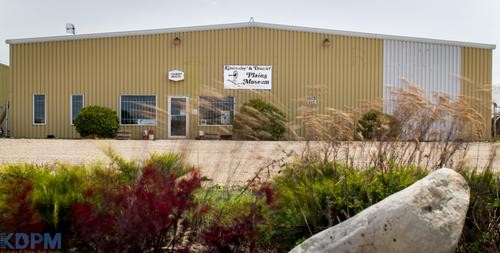
Indigenous Perspectives Being Taught at Kindersley Composite School
Indigenous Perspectives were a major part of learning at Kindersley Composite School this fall both leading up to the National Day for Truth and Reconciliation and following it as well.
On September 19th and 20th, all students in English Language Arts (ELA) A30, Environmental Science 20 and Visual Art 10, 20 and 30 took a trip to the Ancient Echoes Interpretive Centre at Herschel to learn about the historical use of the land by Indigenous peoples. Land near Ancient Echoes includes ceremonial sites, gathering grounds and a buffalo jump and processing area. Students explored these sacred spaces in the natural prairie hills and learned about the unique ecology of the Coalmine Ravine. Students also took in a guided tour of the 18 painting Art Exhibit “The Disappearance and Resurgence of the Buffalo,” by Jo Cooper, on display at the Interpretive Centre.
This field trip brought the curriculum to life for the students in each course.
- ELA A30 students made connections to the theme “Canada’s Landscapes” as well as “Canadian Perspectives – the Glorious and Scandalous.” Walking the hills, hearing the history that exists in the land “right in our own backyard,” understanding the conflicts that still exist on this land today, helped make these topics real for students, especially as they navigate the idea of reconciliation. Students gained a deeper understanding that Indigenous topics and content are not based on “ancient history” but are a part of Canadian identity today.
- Environmental Science 20 students developed photo essays to document their learning. While on the trip they learned how the land is not only an important resource but a powerful learning tool that provides a glimpse of the past and helps shape land use in the future.
- Visual Art 10,20 and 30 students are creating artwork in response to the expressionist style seen in Jo Cooper’s exhibit. Their pieces are based on their investigation into traditional and contemporary aspects of Indigenous Culture in Canada.
Native Studies 20 students also travelled to Ancient Echoes on another day and the visit helped them with their work on completing a big project investigating residential schools and intergenerational trauma affecting all Treaty people. In class, Native Studies 20 students learned about ways that they can advocate for social justice and advocate for Indigenous rights in Canada. As part of an assignment students designed heart shaped wooden medallions to commemorate the lives lost and to honour the survivors of residential schools. This project was inspired by the larger national movement, “Project of the Heart.”
In Art 9 classes, students are learning about Indigenous music and visual art.
- Students investigated a range of traditional and contemporary Indigenous music and learned about various aspects of the music. Based on that music they created album cover art to represent what they have heard.
- They were also introduced to Woodland Cree Art that blends traditional legends and myths with contemporary mediums. Based on their research of a specific artist, students have either recreated a Woodland Cree artwork or developed their own work.
To recognize the National Day of Truth and Reconciliation, On September 28 many students and staff wore orange to show their support for the survivors of residential schools and honour those who did not survive. Some students and staff took the opportunity to learn about some basic smudging practices and participated in one. Classroom teachers used a wide variety of resources to share Indigenous Perspectives with their classes and focus on the importance of Reconciliation.
More recently, on October 17, Kindersley Composite School hosted the Fire Keepers Indigenous Song Circle. Four singer songwriters performed original songs and lead a small workshop for emerging artists afterward.
Above: A selection of pictures from Indigenous Perspective activities at Kindersley Composite School this fall.
Below: The Fire Keepers Indigenous Song Circle.









































